Ossining is the latest town to launch a free food scrap recycling program for residents

Officials and representatives from Ossining, Briarcliff, County Executive George Latimer’s office, State Senator David Carlucci’s office, County Legislator Catherine Borgia’s office, Teatown, Green Ossining, and the Scarsdale Conservation Advisory Council cut the ribbon on the new program.
Here’s what you need to know about the program, as well as the state of food scrap recycling programs county-wide.
The Town of Ossining has officially kicked off a food scrap recycling program for residents of the Town of Ossining (including the Villages of Ossining and Briarcliff Manor), with the help of Teatown and Green Ossining. Residents are now invited to drop off food scraps at Cedar Lane Park (235 Cedar Lane in Ossining) from dawn to dusk, 7 days a week.
Until a more local option is made available, the food scraps will be hauled to the Ulster County Resource Recovery Agency’s Organics Recovery Facility in Kingston, NY. All food scraps collected will be made into compost, which is then sold to garden centers and landscapers.
While residents are welcome to use their own compost bins, full compost kits are available for purchase at Teatown and at the Cedar Lane Arts Center to help residents begin their collection. The kits include one 2-gallon countertop pail, one 6-gallon home storage/transportation bin and one roll of 25 compostable bags. These packages can be purchased for $20 (cash/check) or $21 (credit/ debit card). Kits will soon be also available for purchase at the Ossining Farmers Market.
This project is funded in part by the Environmental Protection Fund as administered by the New York State Department of Environmental Conservation. The Town of Ossining is the recipient of the grant, and Teatown Lake Reservation has been contracted by the Town as a service provider on the grant, providing outreach support. Green Ossining, a joint Town and Village of Ossining volunteer-based committee, will be actively involved in this program, providing volunteer support.
Residents interested can get more information, including a full list of accepted materials, at https://ossiningcomposts.org/. For questions not answered on the website, please email composting@townofossining.com.

The State of Food Scraps in Westchester County
Food scraps are exactly what they sound like. The carrot greens you trimmed off while making soup? Food scraps. The pizza slices you forgot about on the counter overnight? Food scraps. The contents of that terrifying Tupperware at the back of the fridge with some unidentifiable leftovers? You guessed it — food scraps. While food waste happens at all levels from producer to consumer, the scraps we create at home are uniquely under our control and offer an important opportunity to reduce our environmental impact. The vast majority of people throw these scraps in the trash, which ultimately accounts for more than 20% of the waste we send to the incinerator.
Incinerator? Don’t you mean landfill?
Contrary to popular belief, Westchester County’s garbage is not sent to a landfill. Instead, it gets hauled to Peekskill and burned at the Wheelabrator Facility, a waste-to-energy incineration plant. While it may seem odd, burning our waste (including our food scraps) is actually better for the environment than sending it to a landfill because the process produces fewer greenhouse gas emissions. Though food scraps are organic materials and can break down quite readily under the right conditions, the process of layering waste in a landfill is more like leaving your leftover lunch in an airtight plastic bag — forever. It takes much longer to break down and the nutrients are never recycled back into the soil. While incineration may be a slightly better option in terms of emissions, food scraps hold a ton of water and burning is still not an efficient means of disposal.
So what options do we have?
We know that food waste will break down under the right conditions, similar to how organic materials like leaves and sticks decompose on the forest floor, but we can’t all go dumping our food scraps into a nearby park. Instead, we need an organized approach to collecting food scraps and providing them with access to oxygen and water so microorganisms can get to work decomposing the scraps into compost. Composting turns food waste into a so-called ‘black gold’: a nutrient rich soil conditioner that can be used to feed plants naturally without expensive chemical-filled fertilizers.
What is commercial compost?
Composting is becoming more popular across Westchester and many towns have taken up the charge by creating community-wide composting programs. The Town of Ossining officially cut the ribbon on its drop-off site on February 24 (ossiningcomposts.org). Town Supervisor Dana Levenberg is committed to bringing the program to every resident and has partnered with Teatown and Green Ossining for education and outreach while leaning on the experience of municipalities like Scarsdale who have established successful programs — a true community effort.
Programs like Ossining’s invite residents to bring their food scraps to a collection point where they are in turn picked up and brought to a commercial composting facility. For now the closest facility is in Ulster County, meaning towns face the challenge of paying for a truck to regularly haul the scraps almost 100 miles away. That obstacle may soon be erased, however, since Westchester County announced it would start paying for the trips later this year as part of the release of its comprehensive food waste study. In addition to soliciting bids for county-wide hauling services, they plan to create a Westchester County Compost and Education Facility to provide hands-on training to both residents and municipal officials.
What is backyard composting?
If you have the space, composting at home is the gold standard. Not only are you diverting a significant portion of waste out of the waste stream, but you get to reap the rewards of your efforts directly. Whether you purchase a prefab composter or elect for a less formal setup, composting at home is as easy as adding food scraps to a pile and watching it transform over a few months to a year from trash to treasure. A well-kept pile that supports a healthy community of microorganisms with access to oxygen and water will result in a quality compost that can be spread over landscaping, lawns, and potted plants to provide increased nutrient and water holding capacity of the soil. If you’re able to use it in a productive home garden, then you are essentially closing the loop on food waste and working toward a truly sustainable lifestyle. Take note, however, that backyard and commercial compost are not identical processes: backyard piles are much smaller and cannot break down items like meat, oils, and dairy that a commercial facility can support. Whether starting your own pile or participating in your community’s program, be sure to check on what materials are accepted.
Ready to recycle your scraps? Check with your town and see if they already have a program. If not, let them know you’re interested! Ready to try backyard compost? Check out the links below to get started.
https://www.epa.gov/recycle/composting-home
https://www.teatown.org/how-to-compost/
https://www.treehugger.com/lawn-garden/dos-and-donts-backyard-composting.html
https://backyardgrowers.com/23-ingenious-diy-compost-bin-ideas/

About the Author
Nadya Hall
Nadya has her master’s in environmental policy with a focus on human-wildlife coexistence. She is passionate about the conservation of wildlife and wild places through science, advocacy, and environmental education.


